Individual Assignment: MGE1108 Economics for Business Assessment 3
VerifiedAdded on 2022/08/18
|7
|2412
|15
Homework Assignment
AI Summary
This document provides a comprehensive analysis of market structures, including perfect competition, monopoly, monopolistic competition, and oligopoly. The assignment addresses key characteristics of each structure, such as the number of firms, product similarity, and barriers to entry. It then applies these concepts to real-world business examples, identifying the market structure of various companies and explaining the rationale behind the classifications. Furthermore, the assignment explores the concept of a kinked demand curve, using the Coles and Woolworths supermarket chains as an example, and discusses non-price competition. It also defines price discrimination and outlines two methods used by firms. Finally, it analyzes demand curves for monopolistic competition and oligopoly, explaining the differences in their price elasticities of demand. The assignment includes a reference list and in-text citations to support the analysis.
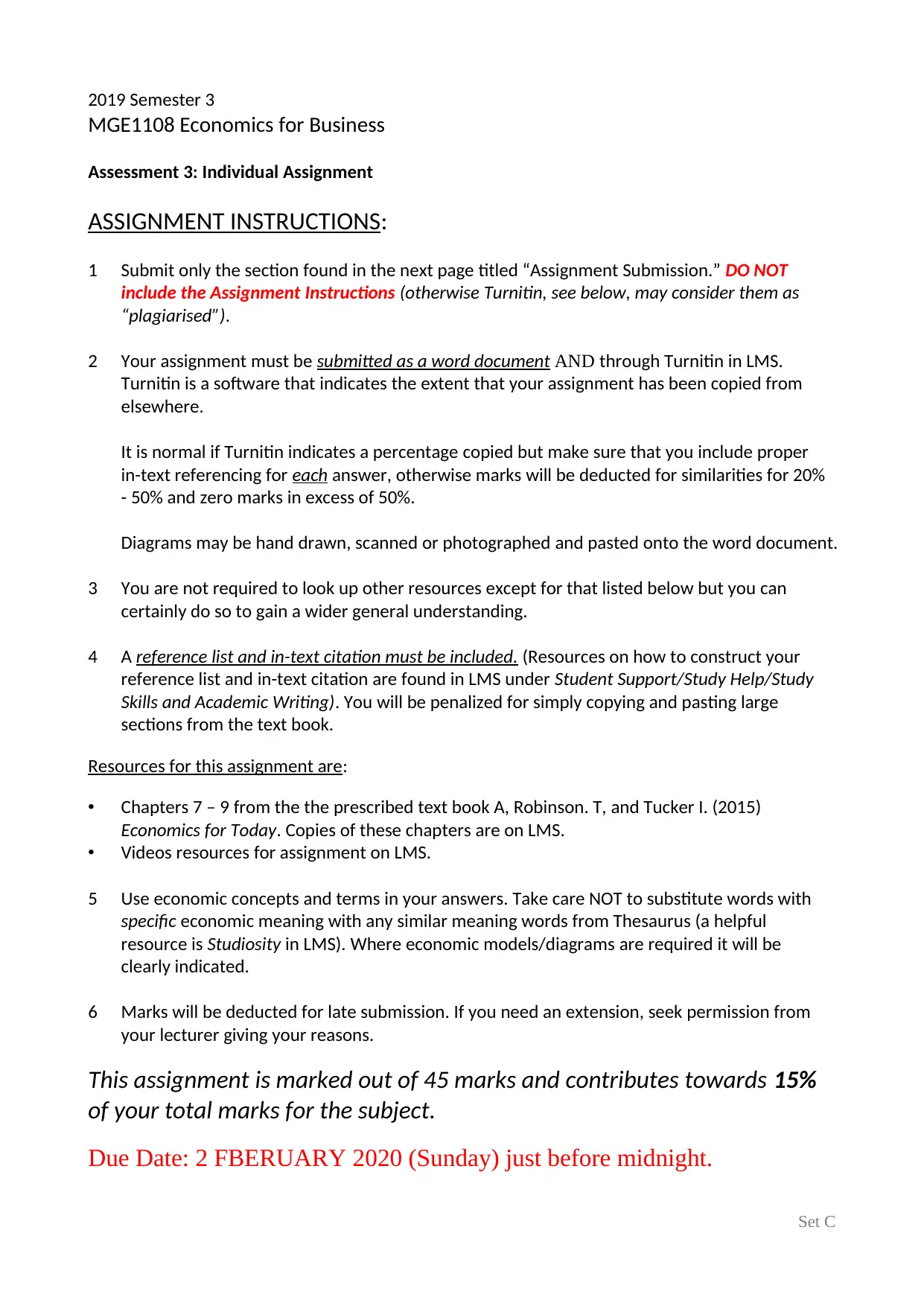
2019 Semester 3
MGE1108 Economics for Business
Assessment 3: Individual Assignment
ASSIGNMENT INSTRUCTIONS:
1 Submit only the section found in the next page titled “Assignment Submission.” DO NOT
include the Assignment Instructions (otherwise Turnitin, see below, may consider them as
“plagiarised”).
2 Your assignment must be submitted as a word document AND through Turnitin in LMS.
Turnitin is a software that indicates the extent that your assignment has been copied from
elsewhere.
It is normal if Turnitin indicates a percentage copied but make sure that you include proper
in-text referencing for each answer, otherwise marks will be deducted for similarities for 20%
- 50% and zero marks in excess of 50%.
Diagrams may be hand drawn, scanned or photographed and pasted onto the word document.
3 You are not required to look up other resources except for that listed below but you can
certainly do so to gain a wider general understanding.
4 A reference list and in-text citation must be included. (Resources on how to construct your
reference list and in-text citation are found in LMS under Student Support/Study Help/Study
Skills and Academic Writing). You will be penalized for simply copying and pasting large
sections from the text book.
Resources for this assignment are:
Chapters 7 – 9 from the the prescribed text book A, Robinson. T, and Tucker I. (2015)
Economics for Today. Copies of these chapters are on LMS.
Videos resources for assignment on LMS.
5 Use economic concepts and terms in your answers. Take care NOT to substitute words with
specific economic meaning with any similar meaning words from Thesaurus (a helpful
resource is Studiosity in LMS). Where economic models/diagrams are required it will be
clearly indicated.
6 Marks will be deducted for late submission. If you need an extension, seek permission from
your lecturer giving your reasons.
This assignment is marked out of 45 marks and contributes towards 15%
of your total marks for the subject.
Due Date: 2 FBERUARY 2020 (Sunday) just before midnight.
Set C
MGE1108 Economics for Business
Assessment 3: Individual Assignment
ASSIGNMENT INSTRUCTIONS:
1 Submit only the section found in the next page titled “Assignment Submission.” DO NOT
include the Assignment Instructions (otherwise Turnitin, see below, may consider them as
“plagiarised”).
2 Your assignment must be submitted as a word document AND through Turnitin in LMS.
Turnitin is a software that indicates the extent that your assignment has been copied from
elsewhere.
It is normal if Turnitin indicates a percentage copied but make sure that you include proper
in-text referencing for each answer, otherwise marks will be deducted for similarities for 20%
- 50% and zero marks in excess of 50%.
Diagrams may be hand drawn, scanned or photographed and pasted onto the word document.
3 You are not required to look up other resources except for that listed below but you can
certainly do so to gain a wider general understanding.
4 A reference list and in-text citation must be included. (Resources on how to construct your
reference list and in-text citation are found in LMS under Student Support/Study Help/Study
Skills and Academic Writing). You will be penalized for simply copying and pasting large
sections from the text book.
Resources for this assignment are:
Chapters 7 – 9 from the the prescribed text book A, Robinson. T, and Tucker I. (2015)
Economics for Today. Copies of these chapters are on LMS.
Videos resources for assignment on LMS.
5 Use economic concepts and terms in your answers. Take care NOT to substitute words with
specific economic meaning with any similar meaning words from Thesaurus (a helpful
resource is Studiosity in LMS). Where economic models/diagrams are required it will be
clearly indicated.
6 Marks will be deducted for late submission. If you need an extension, seek permission from
your lecturer giving your reasons.
This assignment is marked out of 45 marks and contributes towards 15%
of your total marks for the subject.
Due Date: 2 FBERUARY 2020 (Sunday) just before midnight.
Set C
Paraphrase This Document
Need a fresh take? Get an instant paraphrase of this document with our AI Paraphraser
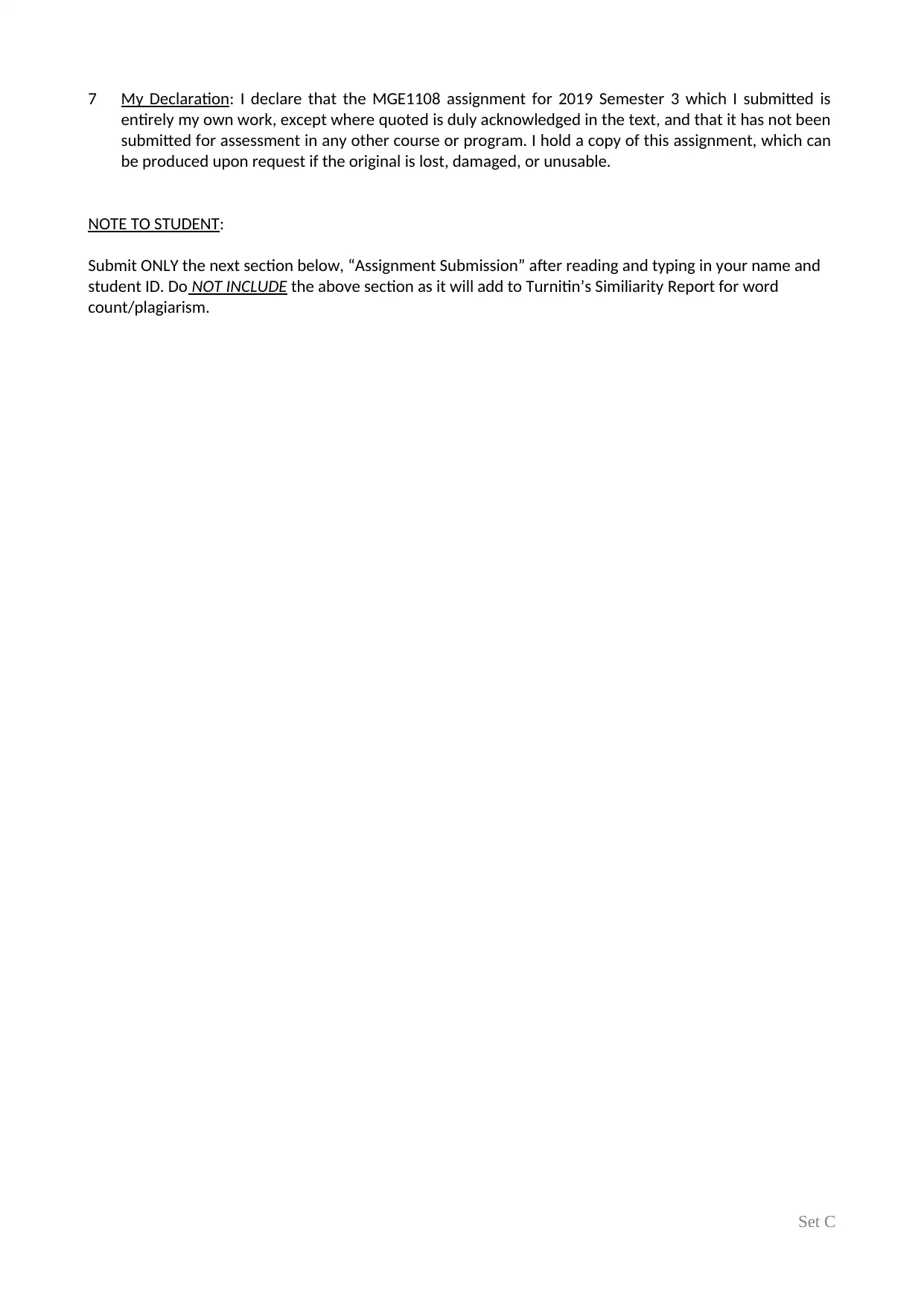
7 My Declaration: I declare that the MGE1108 assignment for 2019 Semester 3 which I submitted is
entirely my own work, except where quoted is duly acknowledged in the text, and that it has not been
submitted for assessment in any other course or program. I hold a copy of this assignment, which can
be produced upon request if the original is lost, damaged, or unusable.
NOTE TO STUDENT:
Submit ONLY the next section below, “Assignment Submission” after reading and typing in your name and
student ID. Do NOT INCLUDE the above section as it will add to Turnitin’s Similiarity Report for word
count/plagiarism.
Set C
entirely my own work, except where quoted is duly acknowledged in the text, and that it has not been
submitted for assessment in any other course or program. I hold a copy of this assignment, which can
be produced upon request if the original is lost, damaged, or unusable.
NOTE TO STUDENT:
Submit ONLY the next section below, “Assignment Submission” after reading and typing in your name and
student ID. Do NOT INCLUDE the above section as it will add to Turnitin’s Similiarity Report for word
count/plagiarism.
Set C
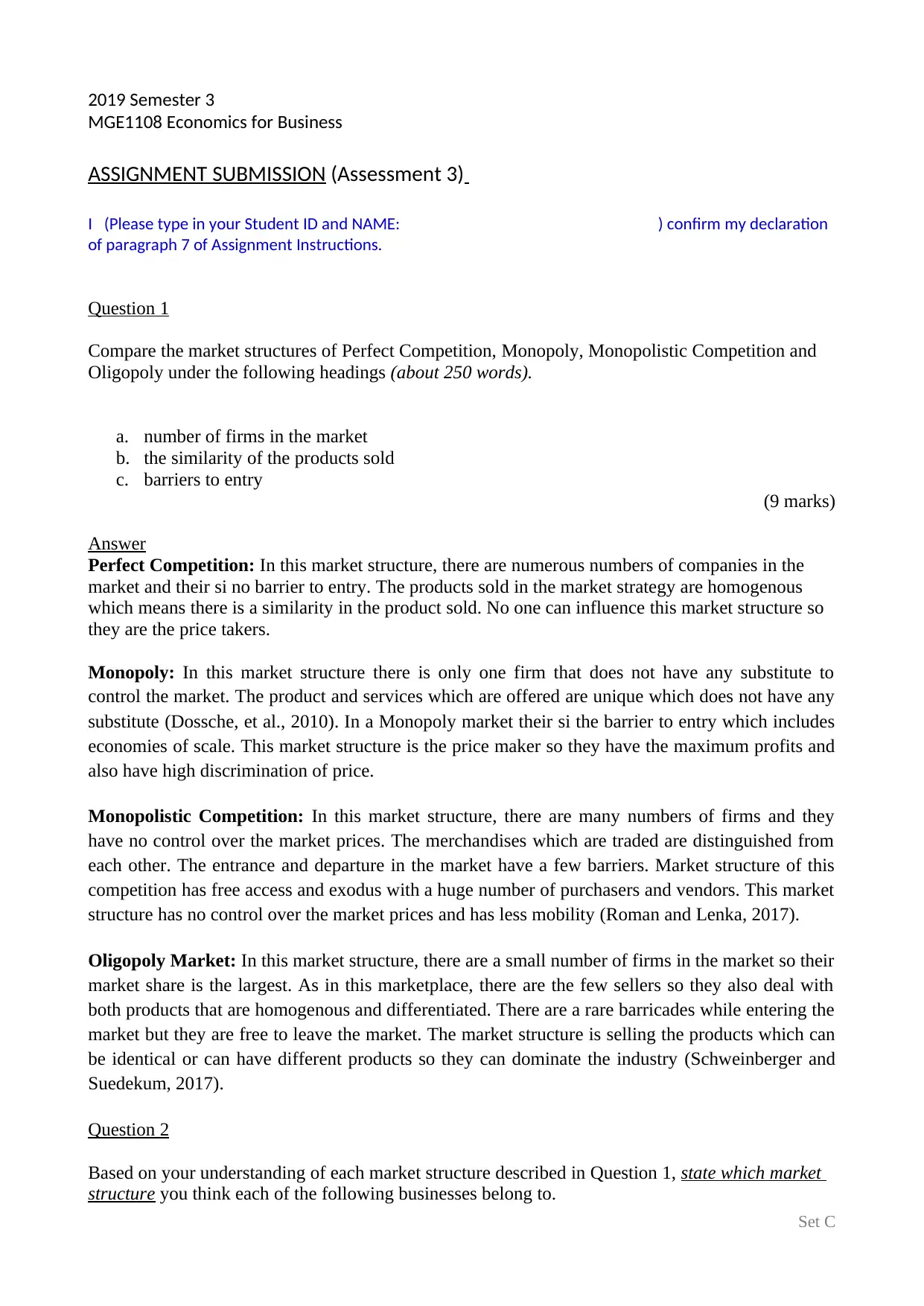
2019 Semester 3
MGE1108 Economics for Business
ASSIGNMENT SUBMISSION (Assessment 3)
I (Please type in your Student ID and NAME: ) confirm my declaration
of paragraph 7 of Assignment Instructions.
Question 1
Compare the market structures of Perfect Competition, Monopoly, Monopolistic Competition and
Oligopoly under the following headings (about 250 words).
a. number of firms in the market
b. the similarity of the products sold
c. barriers to entry
(9 marks)
Answer
Perfect Competition: In this market structure, there are numerous numbers of companies in the
market and their si no barrier to entry. The products sold in the market strategy are homogenous
which means there is a similarity in the product sold. No one can influence this market structure so
they are the price takers.
Monopoly: In this market structure there is only one firm that does not have any substitute to
control the market. The product and services which are offered are unique which does not have any
substitute (Dossche, et al., 2010). In a Monopoly market their si the barrier to entry which includes
economies of scale. This market structure is the price maker so they have the maximum profits and
also have high discrimination of price.
Monopolistic Competition: In this market structure, there are many numbers of firms and they
have no control over the market prices. The merchandises which are traded are distinguished from
each other. The entrance and departure in the market have a few barriers. Market structure of this
competition has free access and exodus with a huge number of purchasers and vendors. This market
structure has no control over the market prices and has less mobility (Roman and Lenka, 2017).
Oligopoly Market: In this market structure, there are a small number of firms in the market so their
market share is the largest. As in this marketplace, there are the few sellers so they also deal with
both products that are homogenous and differentiated. There are a rare barricades while entering the
market but they are free to leave the market. The market structure is selling the products which can
be identical or can have different products so they can dominate the industry (Schweinberger and
Suedekum, 2017).
Question 2
Based on your understanding of each market structure described in Question 1, state which market
structure you think each of the following businesses belong to.
Set C
MGE1108 Economics for Business
ASSIGNMENT SUBMISSION (Assessment 3)
I (Please type in your Student ID and NAME: ) confirm my declaration
of paragraph 7 of Assignment Instructions.
Question 1
Compare the market structures of Perfect Competition, Monopoly, Monopolistic Competition and
Oligopoly under the following headings (about 250 words).
a. number of firms in the market
b. the similarity of the products sold
c. barriers to entry
(9 marks)
Answer
Perfect Competition: In this market structure, there are numerous numbers of companies in the
market and their si no barrier to entry. The products sold in the market strategy are homogenous
which means there is a similarity in the product sold. No one can influence this market structure so
they are the price takers.
Monopoly: In this market structure there is only one firm that does not have any substitute to
control the market. The product and services which are offered are unique which does not have any
substitute (Dossche, et al., 2010). In a Monopoly market their si the barrier to entry which includes
economies of scale. This market structure is the price maker so they have the maximum profits and
also have high discrimination of price.
Monopolistic Competition: In this market structure, there are many numbers of firms and they
have no control over the market prices. The merchandises which are traded are distinguished from
each other. The entrance and departure in the market have a few barriers. Market structure of this
competition has free access and exodus with a huge number of purchasers and vendors. This market
structure has no control over the market prices and has less mobility (Roman and Lenka, 2017).
Oligopoly Market: In this market structure, there are a small number of firms in the market so their
market share is the largest. As in this marketplace, there are the few sellers so they also deal with
both products that are homogenous and differentiated. There are a rare barricades while entering the
market but they are free to leave the market. The market structure is selling the products which can
be identical or can have different products so they can dominate the industry (Schweinberger and
Suedekum, 2017).
Question 2
Based on your understanding of each market structure described in Question 1, state which market
structure you think each of the following businesses belong to.
Set C
⊘ This is a preview!⊘
Do you want full access?
Subscribe today to unlock all pages.

Trusted by 1+ million students worldwide
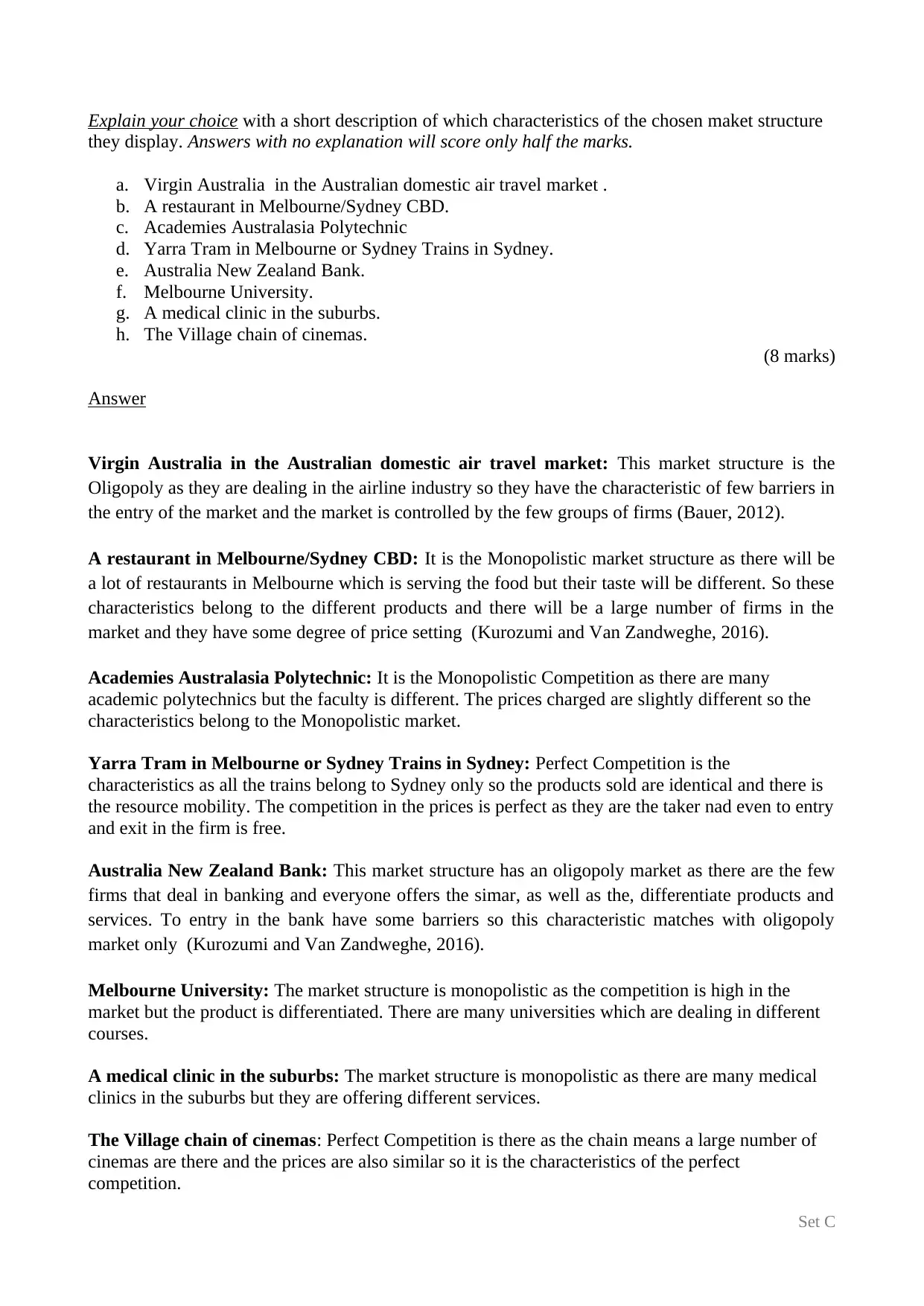
Explain your choice with a short description of which characteristics of the chosen maket structure
they display. Answers with no explanation will score only half the marks.
a. Virgin Australia in the Australian domestic air travel market .
b. A restaurant in Melbourne/Sydney CBD.
c. Academies Australasia Polytechnic
d. Yarra Tram in Melbourne or Sydney Trains in Sydney.
e. Australia New Zealand Bank.
f. Melbourne University.
g. A medical clinic in the suburbs.
h. The Village chain of cinemas.
(8 marks)
Answer
Virgin Australia in the Australian domestic air travel market: This market structure is the
Oligopoly as they are dealing in the airline industry so they have the characteristic of few barriers in
the entry of the market and the market is controlled by the few groups of firms (Bauer, 2012).
A restaurant in Melbourne/Sydney CBD: It is the Monopolistic market structure as there will be
a lot of restaurants in Melbourne which is serving the food but their taste will be different. So these
characteristics belong to the different products and there will be a large number of firms in the
market and they have some degree of price setting (Kurozumi and Van Zandweghe, 2016).
Academies Australasia Polytechnic: It is the Monopolistic Competition as there are many
academic polytechnics but the faculty is different. The prices charged are slightly different so the
characteristics belong to the Monopolistic market.
Yarra Tram in Melbourne or Sydney Trains in Sydney: Perfect Competition is the
characteristics as all the trains belong to Sydney only so the products sold are identical and there is
the resource mobility. The competition in the prices is perfect as they are the taker nad even to entry
and exit in the firm is free.
Australia New Zealand Bank: This market structure has an oligopoly market as there are the few
firms that deal in banking and everyone offers the simar, as well as the, differentiate products and
services. To entry in the bank have some barriers so this characteristic matches with oligopoly
market only (Kurozumi and Van Zandweghe, 2016).
Melbourne University: The market structure is monopolistic as the competition is high in the
market but the product is differentiated. There are many universities which are dealing in different
courses.
A medical clinic in the suburbs: The market structure is monopolistic as there are many medical
clinics in the suburbs but they are offering different services.
The Village chain of cinemas: Perfect Competition is there as the chain means a large number of
cinemas are there and the prices are also similar so it is the characteristics of the perfect
competition.
Set C
they display. Answers with no explanation will score only half the marks.
a. Virgin Australia in the Australian domestic air travel market .
b. A restaurant in Melbourne/Sydney CBD.
c. Academies Australasia Polytechnic
d. Yarra Tram in Melbourne or Sydney Trains in Sydney.
e. Australia New Zealand Bank.
f. Melbourne University.
g. A medical clinic in the suburbs.
h. The Village chain of cinemas.
(8 marks)
Answer
Virgin Australia in the Australian domestic air travel market: This market structure is the
Oligopoly as they are dealing in the airline industry so they have the characteristic of few barriers in
the entry of the market and the market is controlled by the few groups of firms (Bauer, 2012).
A restaurant in Melbourne/Sydney CBD: It is the Monopolistic market structure as there will be
a lot of restaurants in Melbourne which is serving the food but their taste will be different. So these
characteristics belong to the different products and there will be a large number of firms in the
market and they have some degree of price setting (Kurozumi and Van Zandweghe, 2016).
Academies Australasia Polytechnic: It is the Monopolistic Competition as there are many
academic polytechnics but the faculty is different. The prices charged are slightly different so the
characteristics belong to the Monopolistic market.
Yarra Tram in Melbourne or Sydney Trains in Sydney: Perfect Competition is the
characteristics as all the trains belong to Sydney only so the products sold are identical and there is
the resource mobility. The competition in the prices is perfect as they are the taker nad even to entry
and exit in the firm is free.
Australia New Zealand Bank: This market structure has an oligopoly market as there are the few
firms that deal in banking and everyone offers the simar, as well as the, differentiate products and
services. To entry in the bank have some barriers so this characteristic matches with oligopoly
market only (Kurozumi and Van Zandweghe, 2016).
Melbourne University: The market structure is monopolistic as the competition is high in the
market but the product is differentiated. There are many universities which are dealing in different
courses.
A medical clinic in the suburbs: The market structure is monopolistic as there are many medical
clinics in the suburbs but they are offering different services.
The Village chain of cinemas: Perfect Competition is there as the chain means a large number of
cinemas are there and the prices are also similar so it is the characteristics of the perfect
competition.
Set C
Paraphrase This Document
Need a fresh take? Get an instant paraphrase of this document with our AI Paraphraser
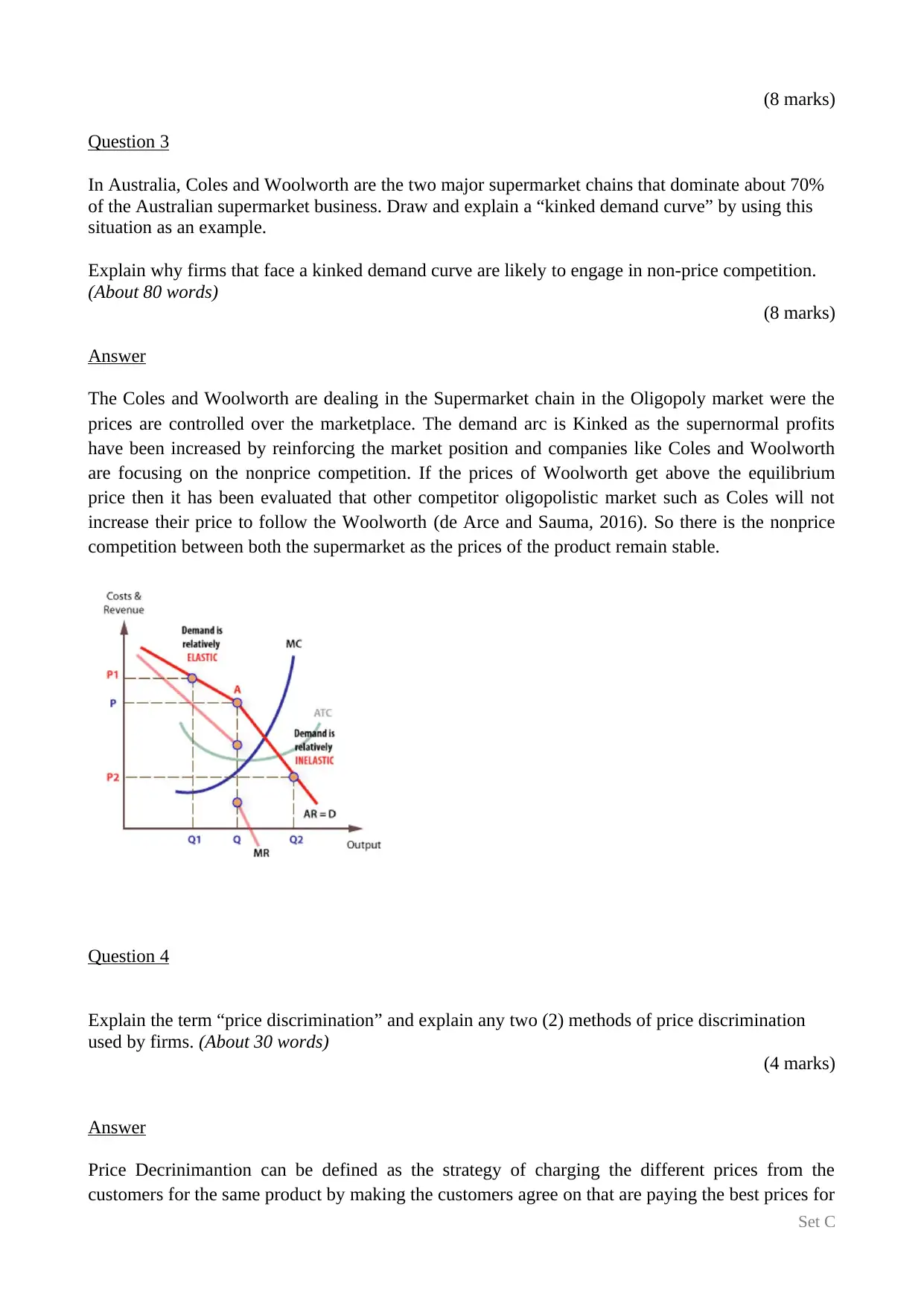
(8 marks)
Question 3
In Australia, Coles and Woolworth are the two major supermarket chains that dominate about 70%
of the Australian supermarket business. Draw and explain a “kinked demand curve” by using this
situation as an example.
Explain why firms that face a kinked demand curve are likely to engage in non-price competition.
(About 80 words)
(8 marks)
Answer
The Coles and Woolworth are dealing in the Supermarket chain in the Oligopoly market were the
prices are controlled over the marketplace. The demand arc is Kinked as the supernormal profits
have been increased by reinforcing the market position and companies like Coles and Woolworth
are focusing on the nonprice competition. If the prices of Woolworth get above the equilibrium
price then it has been evaluated that other competitor oligopolistic market such as Coles will not
increase their price to follow the Woolworth (de Arce and Sauma, 2016). So there is the nonprice
competition between both the supermarket as the prices of the product remain stable.
Question 4
Explain the term “price discrimination” and explain any two (2) methods of price discrimination
used by firms. (About 30 words)
(4 marks)
Answer
Price Decrinimantion can be defined as the strategy of charging the different prices from the
customers for the same product by making the customers agree on that are paying the best prices for
Set C
Question 3
In Australia, Coles and Woolworth are the two major supermarket chains that dominate about 70%
of the Australian supermarket business. Draw and explain a “kinked demand curve” by using this
situation as an example.
Explain why firms that face a kinked demand curve are likely to engage in non-price competition.
(About 80 words)
(8 marks)
Answer
The Coles and Woolworth are dealing in the Supermarket chain in the Oligopoly market were the
prices are controlled over the marketplace. The demand arc is Kinked as the supernormal profits
have been increased by reinforcing the market position and companies like Coles and Woolworth
are focusing on the nonprice competition. If the prices of Woolworth get above the equilibrium
price then it has been evaluated that other competitor oligopolistic market such as Coles will not
increase their price to follow the Woolworth (de Arce and Sauma, 2016). So there is the nonprice
competition between both the supermarket as the prices of the product remain stable.
Question 4
Explain the term “price discrimination” and explain any two (2) methods of price discrimination
used by firms. (About 30 words)
(4 marks)
Answer
Price Decrinimantion can be defined as the strategy of charging the different prices from the
customers for the same product by making the customers agree on that are paying the best prices for
Set C
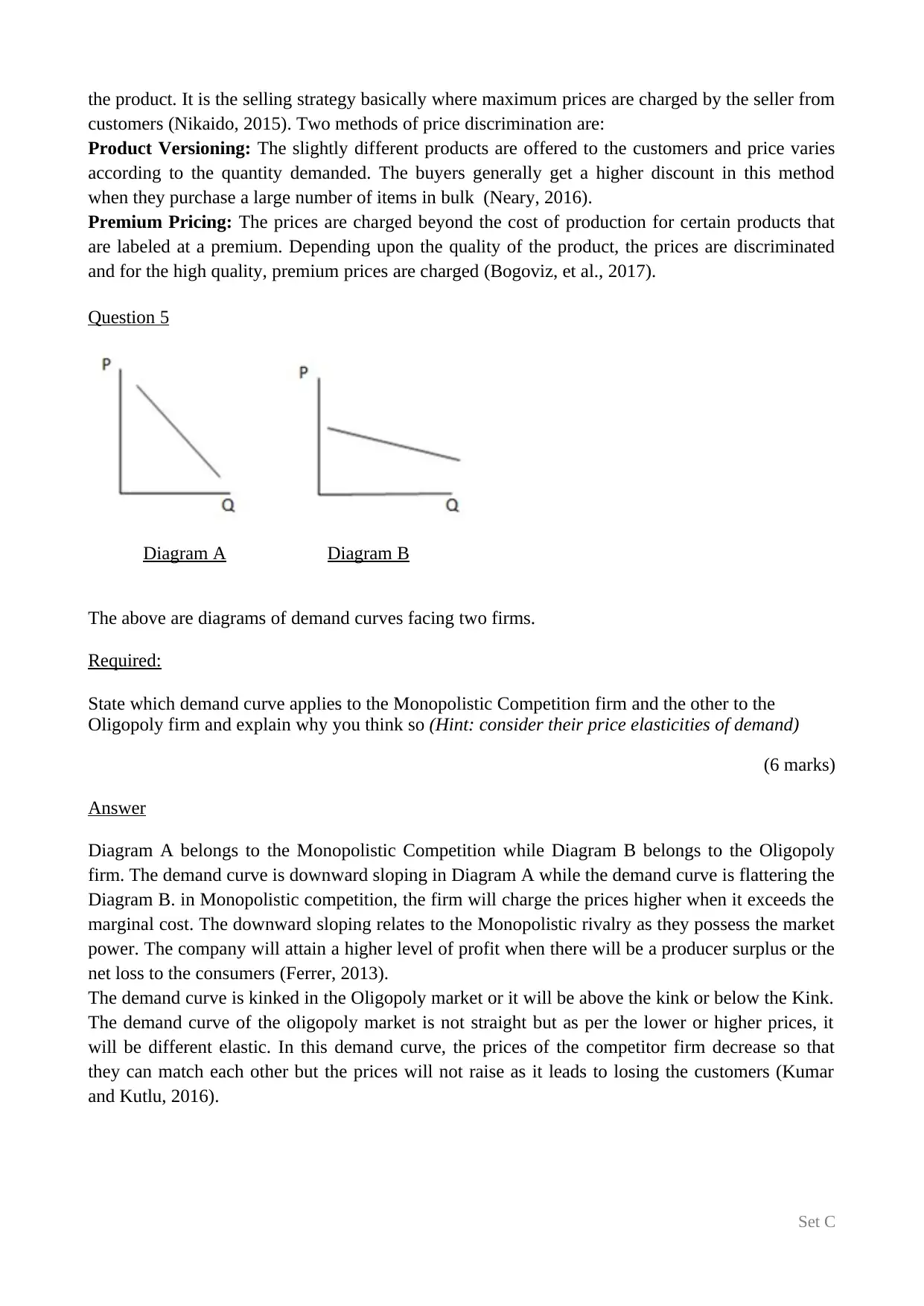
the product. It is the selling strategy basically where maximum prices are charged by the seller from
customers (Nikaido, 2015). Two methods of price discrimination are:
Product Versioning: The slightly different products are offered to the customers and price varies
according to the quantity demanded. The buyers generally get a higher discount in this method
when they purchase a large number of items in bulk (Neary, 2016).
Premium Pricing: The prices are charged beyond the cost of production for certain products that
are labeled at a premium. Depending upon the quality of the product, the prices are discriminated
and for the high quality, premium prices are charged (Bogoviz, et al., 2017).
Question 5
Diagram A Diagram B
The above are diagrams of demand curves facing two firms.
Required:
State which demand curve applies to the Monopolistic Competition firm and the other to the
Oligopoly firm and explain why you think so (Hint: consider their price elasticities of demand)
(6 marks)
Answer
Diagram A belongs to the Monopolistic Competition while Diagram B belongs to the Oligopoly
firm. The demand curve is downward sloping in Diagram A while the demand curve is flattering the
Diagram B. in Monopolistic competition, the firm will charge the prices higher when it exceeds the
marginal cost. The downward sloping relates to the Monopolistic rivalry as they possess the market
power. The company will attain a higher level of profit when there will be a producer surplus or the
net loss to the consumers (Ferrer, 2013).
The demand curve is kinked in the Oligopoly market or it will be above the kink or below the Kink.
The demand curve of the oligopoly market is not straight but as per the lower or higher prices, it
will be different elastic. In this demand curve, the prices of the competitor firm decrease so that
they can match each other but the prices will not raise as it leads to losing the customers (Kumar
and Kutlu, 2016).
Set C
customers (Nikaido, 2015). Two methods of price discrimination are:
Product Versioning: The slightly different products are offered to the customers and price varies
according to the quantity demanded. The buyers generally get a higher discount in this method
when they purchase a large number of items in bulk (Neary, 2016).
Premium Pricing: The prices are charged beyond the cost of production for certain products that
are labeled at a premium. Depending upon the quality of the product, the prices are discriminated
and for the high quality, premium prices are charged (Bogoviz, et al., 2017).
Question 5
Diagram A Diagram B
The above are diagrams of demand curves facing two firms.
Required:
State which demand curve applies to the Monopolistic Competition firm and the other to the
Oligopoly firm and explain why you think so (Hint: consider their price elasticities of demand)
(6 marks)
Answer
Diagram A belongs to the Monopolistic Competition while Diagram B belongs to the Oligopoly
firm. The demand curve is downward sloping in Diagram A while the demand curve is flattering the
Diagram B. in Monopolistic competition, the firm will charge the prices higher when it exceeds the
marginal cost. The downward sloping relates to the Monopolistic rivalry as they possess the market
power. The company will attain a higher level of profit when there will be a producer surplus or the
net loss to the consumers (Ferrer, 2013).
The demand curve is kinked in the Oligopoly market or it will be above the kink or below the Kink.
The demand curve of the oligopoly market is not straight but as per the lower or higher prices, it
will be different elastic. In this demand curve, the prices of the competitor firm decrease so that
they can match each other but the prices will not raise as it leads to losing the customers (Kumar
and Kutlu, 2016).
Set C
⊘ This is a preview!⊘
Do you want full access?
Subscribe today to unlock all pages.

Trusted by 1+ million students worldwide
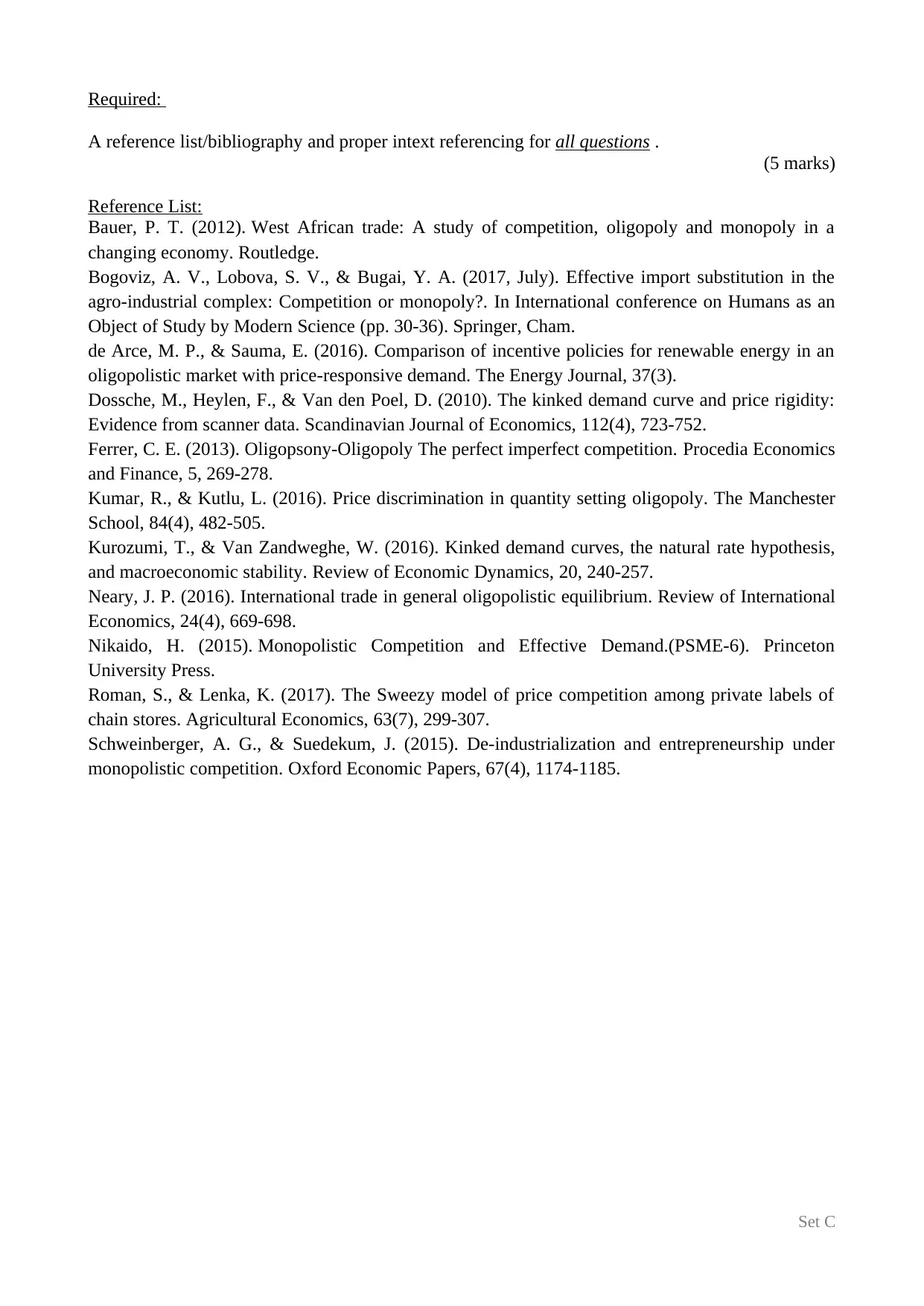
Required:
A reference list/bibliography and proper intext referencing for all questions .
(5 marks)
Reference List:
Bauer, P. T. (2012). West African trade: A study of competition, oligopoly and monopoly in a
changing economy. Routledge.
Bogoviz, A. V., Lobova, S. V., & Bugai, Y. A. (2017, July). Effective import substitution in the
agro-industrial complex: Competition or monopoly?. In International conference on Humans as an
Object of Study by Modern Science (pp. 30-36). Springer, Cham.
de Arce, M. P., & Sauma, E. (2016). Comparison of incentive policies for renewable energy in an
oligopolistic market with price-responsive demand. The Energy Journal, 37(3).
Dossche, M., Heylen, F., & Van den Poel, D. (2010). The kinked demand curve and price rigidity:
Evidence from scanner data. Scandinavian Journal of Economics, 112(4), 723-752.
Ferrer, C. E. (2013). Oligopsony-Oligopoly The perfect imperfect competition. Procedia Economics
and Finance, 5, 269-278.
Kumar, R., & Kutlu, L. (2016). Price discrimination in quantity setting oligopoly. The Manchester
School, 84(4), 482-505.
Kurozumi, T., & Van Zandweghe, W. (2016). Kinked demand curves, the natural rate hypothesis,
and macroeconomic stability. Review of Economic Dynamics, 20, 240-257.
Neary, J. P. (2016). International trade in general oligopolistic equilibrium. Review of International
Economics, 24(4), 669-698.
Nikaido, H. (2015). Monopolistic Competition and Effective Demand.(PSME-6). Princeton
University Press.
Roman, S., & Lenka, K. (2017). The Sweezy model of price competition among private labels of
chain stores. Agricultural Economics, 63(7), 299-307.
Schweinberger, A. G., & Suedekum, J. (2015). De-industrialization and entrepreneurship under
monopolistic competition. Oxford Economic Papers, 67(4), 1174-1185.
Set C
A reference list/bibliography and proper intext referencing for all questions .
(5 marks)
Reference List:
Bauer, P. T. (2012). West African trade: A study of competition, oligopoly and monopoly in a
changing economy. Routledge.
Bogoviz, A. V., Lobova, S. V., & Bugai, Y. A. (2017, July). Effective import substitution in the
agro-industrial complex: Competition or monopoly?. In International conference on Humans as an
Object of Study by Modern Science (pp. 30-36). Springer, Cham.
de Arce, M. P., & Sauma, E. (2016). Comparison of incentive policies for renewable energy in an
oligopolistic market with price-responsive demand. The Energy Journal, 37(3).
Dossche, M., Heylen, F., & Van den Poel, D. (2010). The kinked demand curve and price rigidity:
Evidence from scanner data. Scandinavian Journal of Economics, 112(4), 723-752.
Ferrer, C. E. (2013). Oligopsony-Oligopoly The perfect imperfect competition. Procedia Economics
and Finance, 5, 269-278.
Kumar, R., & Kutlu, L. (2016). Price discrimination in quantity setting oligopoly. The Manchester
School, 84(4), 482-505.
Kurozumi, T., & Van Zandweghe, W. (2016). Kinked demand curves, the natural rate hypothesis,
and macroeconomic stability. Review of Economic Dynamics, 20, 240-257.
Neary, J. P. (2016). International trade in general oligopolistic equilibrium. Review of International
Economics, 24(4), 669-698.
Nikaido, H. (2015). Monopolistic Competition and Effective Demand.(PSME-6). Princeton
University Press.
Roman, S., & Lenka, K. (2017). The Sweezy model of price competition among private labels of
chain stores. Agricultural Economics, 63(7), 299-307.
Schweinberger, A. G., & Suedekum, J. (2015). De-industrialization and entrepreneurship under
monopolistic competition. Oxford Economic Papers, 67(4), 1174-1185.
Set C
1 out of 7
Related Documents
Your All-in-One AI-Powered Toolkit for Academic Success.
+13062052269
info@desklib.com
Available 24*7 on WhatsApp / Email
![[object Object]](/_next/static/media/star-bottom.7253800d.svg)
Unlock your academic potential
Copyright © 2020–2025 A2Z Services. All Rights Reserved. Developed and managed by ZUCOL.





